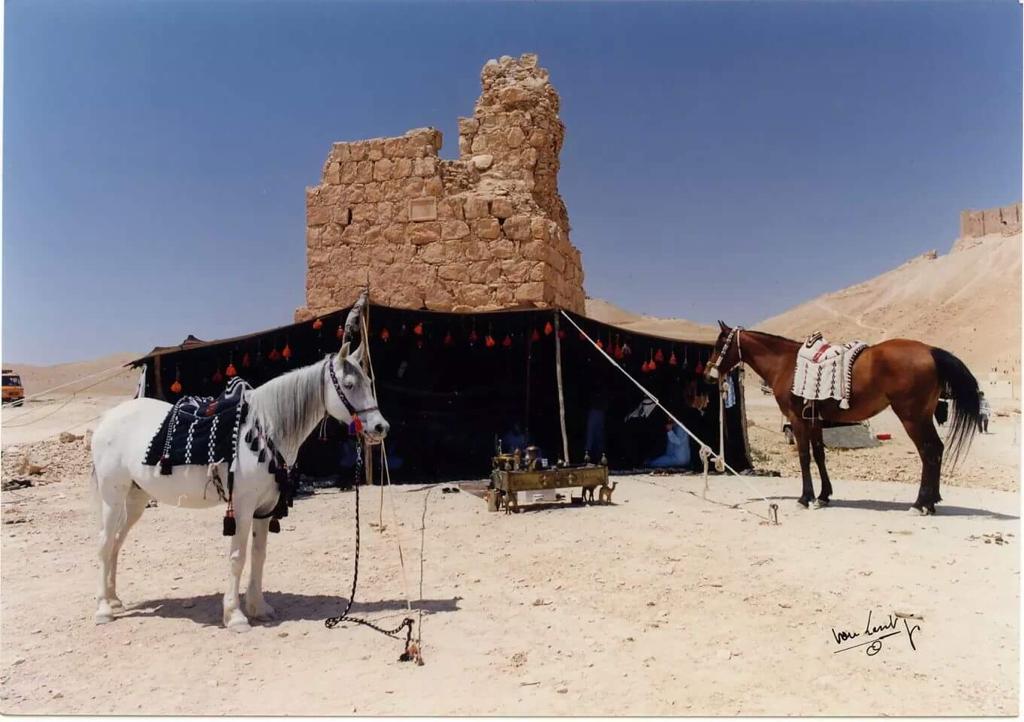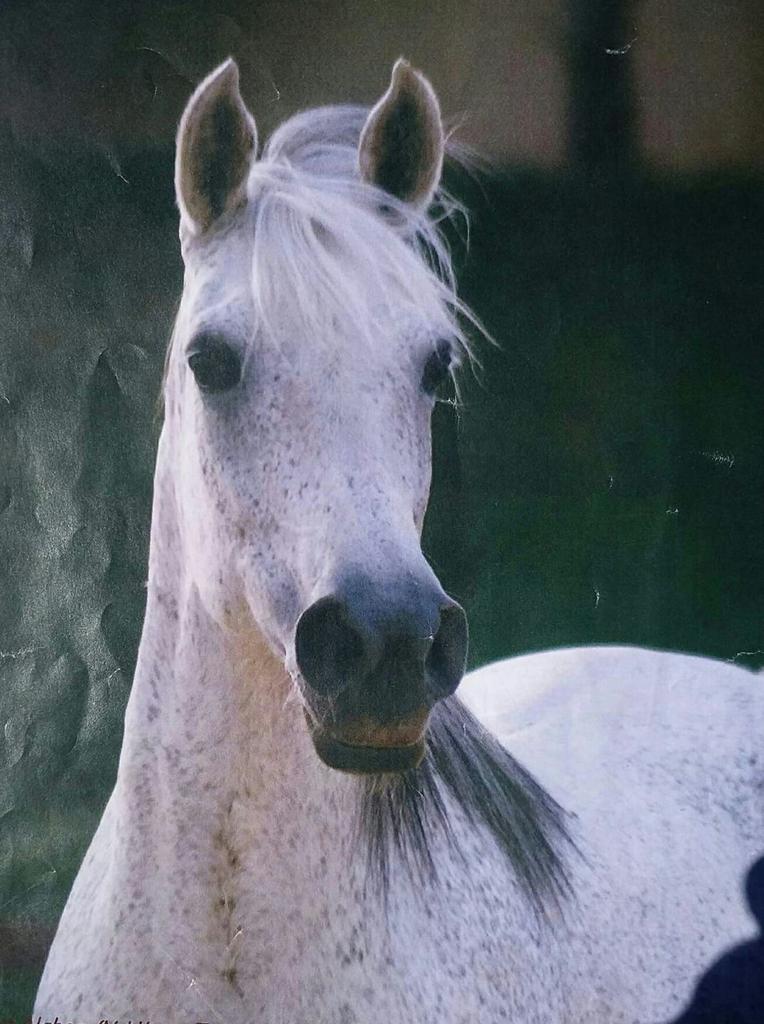Saqlawi Nijm al-Subh in the Abbas Pasha Manuscript and today
Each of the eleven chapters of the Abbas Pasha Manuscript in its Arabic version starts with a table. The table lists the titles of the accounts on every marbat and the page number where the account begins. Sometimes the title includes information not present in the body of the account.
There are six sections under the general title “Chapter Three on the Saqlawiyaat”. Section One is on the Saqlawi Simni, section Two is on the Saqlawi Sudani, and so on. The last section, “Section Six on stand-alone Saqlawiyaat” is where the author of the Manuscript grouped those Saqlawiyaat not falling under the previous five sections. This sixth section includes the following title entry: “Accounts of the parti-coloured (rabshah) Najmat al-Subh, the mare of Hussayn al-‘Awwadi, page 129“. Here is my translation of the account on page 129:
Accounts of the parti-coloured (rabshah) Saqlawiyah, the mare of Hussayn al-‘Awwadi of al-Ghubayn, her sire is al-Mahyubi.
Saddah ibn Jadran informed that: “This mare belonged to a Ruwalah man [who was] in al-Jazirah, beholden (qasir) to Farhan al-Jarba. The Ghubayn [clan] had unhorsed him [in a raid] and taken her. She is Saqlawiyah of al-Njaymaat. Her dam had passed to the Ruwalah from Ahl al-Jabal. She [the mare herself or her dam line, unclear] had passed to Ahl al-Jabal from [the tribe of] al-Sarhan, Ibn Ramlah [in particular]. Ibn Ramlah is the owner of the marbat. She [the line] had passed to him [i.e., to Ibn Ramlah] from Bani Sakhr, [and] Ibn Bakr [in particular].
My notes:
1/ al-Jazirah: the land between Tigris and Euphrates and tribal homeland of the Northern Shammar.
2/ rabshah: literally, “of different colors, one red spot and one black or dust-colored spot“, according to the 730 years old Arabic dictionary Lesan al-Arab.
3/ al-Ghubayn: the paramount clan of the Fad’aan tribe at the time the Manuscript was produced. Hussayn al-Awwadi the owner of that mare was from the Ghubayn clan of the Fad’aan.
4/ Saddah Ibn Jadran: the owner of the Saqlawi Jadran strain, and a Ruwalah tribesmen, so a person well placed to know the story of the unnamed Ruwalah man beholden to the Northern Shammar leader Farhan al-Jarba.
5/ Qasir: a Bedouin concept, meaning a man beholden to someone else, usually the leader of another tribe, as a result of having sought refuge with him for economic reasons. In other words, an economic refugee.
6/ al-Njaymaat: The plural name of the Nijm al-Subh, a branch of the Saqlawiyaat.
7/ Ruwalah man: He is left unnamed.
8/ Ahl al-Jabal: “The people of the mountain”: a common for a collection of smaller, ancient tribes that had been pushed by Anazah into Jabal al-Arab, the “Mountain of the Arabs”, in Southern Syria. They include the Sardiyah and Aal Issa tribes.
This account narrates the relatively simple story of the passing of the Saqlawiyat Nijm al-Subh from one owner to another, as follows:
Ibn Bakr of Bani Sakhr –> Ibn Ramlah of al-Sirhan, owners of the marbat of Nijm al-Subh –> Ahl al-Jabal –> Ruwalah –> Unnamed Ruwalah man beholden to Farhan al-Jarba the Shaykh of Shammar –> Hussayn al-‘Awwadi of al-Ghubayn of Fad’aan in a raid.
The mare of Hussayn al-‘Awwadi had reached the Abbas Pasha Stud, which is why Abbas Pasha’s envoys went inquiring about her with the Bedouins.
The story of this strain does not end there. The Shammar, in their oral accounts, tell the fascinating story of a Saqlawiyah Nijm al-Subh mare, which a Ruwalah man, then staying with the Shammar had to surrender to the Shammar artisans clan of the Maraziq “as blood money” (diyyah) for a dog he had killed. I heard the story many times:
The visiting Ruwalah man had apparently ventured to the women side of a tent of the Maraziq. The Maraziq were a clan of artisans of the Shammar, named after the main tool of their trade, the marzaqah, or loom. They wove tents, pillows, tent dividers, etc. They were not warriors, so did not have horses or weapons. They were not shepherds or slaves, either. Warriors, shepherds, artisans and slaves formed the four strata of Bedouin society.
The Maraziq relied on a dog for protection. The dog attacked the nosy visitor, who killed it. Commotion ensued, and the defenseless Maraziq complained. Tribal judges then ruled that the man had to surrender his precious Saqlawiyah Najmat al-Subh (‘star of the morning’) mare to the Maraziq, to repair the offence he had committed by peeking into the private space of their tent. The story then spread that the precious mare was handed to the Maraziq as blood money for the dog — which is not quite true, because blood money is paid for human lives only, not animal lives.
Owning a mare, and a Saqlawiyah at that, was such a big deal for the Maraziq as a collective that over the years they have cared for this strain as they would for their family members. They went to great length to breed their Saqlawiyaat Nijmat al-Subh mares only to the very best Shammar stallions. Over the years, their horses became known for their speed and beauty. They gave the Shammar tribe some of its best herd sires. Among these: Ghuzayyil who raced in Beirut in the 1950s before coming back to the Shammar as a herdsire; the Black Marzaqani, which the Anazah eventually took; the bay, lame Marzaqani “Abu Kift” who was heavily used in the 1960s; another black Marzaqani, the “horse of al-‘Anud” the daughter of the Shaykh of Tai in the 1970s; and the chestnut “horse of Karmo” in the 1980s, one of the last Shammar herdsires. There was also Mawj Al-Athir, who became a sire for the government of Lebanon. The strain remains treasured with the Maraziq until today, and its stallions are still preferred over others by the Shammar. Current Maraziq owners of the strain include: Uwaid Ramadan Awwad al-Marzaqani, Farhud Jad’aan al-Marzaqani, ‘Iyadah al-Marzaqani, ‘Adhaab al-Marzaqani and others I forget.
Below, Tairah, the beautiful grey Saqlawiyah Marzaqaniyah of Basil Jadaan pictured against the backdrop of a Bedouin tent at the Desert Festival in Palmyra. Below that, two photos of Tairah’s daughter Bariat al-Sham, by Mokhtar. Basil unfortunately lost the tail female line for Tairah, but retains it in the middle of his horses’ pedigrees.



I am really enjoying all these posts! One question – how did the Saqlawi Nijm al-Subh get its name? It doesn’t seem to be named for its owners, nor for a physical trait.
it’s a mystery.
Saqlawi Nijm al-Subh tracking back originally to Ramlah bin jemass from al fadal rabiaah who was the emir of al-Sirhan tribe and there is a relationship of close cousins with bani sakhr.. so it’s not saqlawiyah Jadraniya Because Ibn Gadran had got it late from them.. plus she is older than ibn Gadran nearly 400 years and more because al sirhan they were staying in al jouf area /the North of arabian Peninsula Saudia and Jordan border, Before coming al Ruwalah to that area plus al sirhan had been governed al jouf.
and abut al jabal… the was meaning in manuscript.. Jabal shammar of (hail) or jabal of Tayy tribes
http://www.alnssabon.com/242693-post3.html
You are right, she is not Jadraniyah, both Jadran and Ibn Ramlah got their Salqawiyah from Ibn Bakr of Bani Sakhr who got her from al-Sardiyah (Ibn Dalmaz) who got her from the Mawali (Aal Abu Rishah), who got her from Aal Fadl of Tai. Correct?
sorry just for correction : rammlah bin jemass Al fadal Rabi’ah from Tayy .. so finely saqlawiyah’t najmat al subh from saqlawiyah’t isa al muhann ibn fadal Rabi’ah from Tayy. its saqlawiyah originally in strine before Before falling into the hands of the Ruwalah.
No. Check the manuscript. Ibn Ramlah got his Nijm al-Subh from Ibn Bakr of Bani Sakhr. And Jadran also got his Saqlawiyah from ibn Bakr of Bani Sakhr.
Yes, like you said, the Sirhan were in the Jauf area (the Wadi Sirhan is known after them as you know). The Anazah were coming from the Hijaz (Khaibar) towards the north, and pushed the Sirhan out of al-Jawf, into Hauran and Northern Jordan (Balqaa).
I am so sad that Basil has lost these beautiful mares and their female line.